Bringing Habitat Home

Forward by Dan Cahill, Land Steward
Collective work has emerged in Burlington to bring presence and healing to our small and large open spaces. Burlington Parks Recreation and Waterfront, along with a multitude of individuals, institutions and initiatives have been working together to weave a patchwork of care and stewardship that acknowledges our natural world from the bedrock to the birds. In this article Braden DeForge courageously explores the passion and interest behind some of the humans in Burlington working to address climate change with nature based solutions.
_____
This spring, as the birds called, leaves emerged, and we explored our newly thawed city. The Burlington Parks Recreation and Waterfront Conservation Team was hard at work implementing planting projects in our neighborhoods. BPRW collaborated with its partners in science and nature based solutions projects to combat climate change, increase pollinator and bird habitat, and enhance biodiversity within the city.
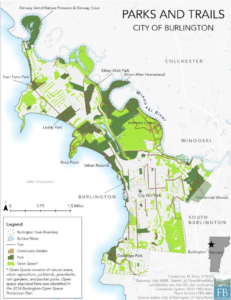
The city holds many rich natural areas, and when you account for backyards, and other green spaces the overall open space in Burlington makes up about 49% of the land mass. In recent years, one might have noticed new initiatives and projects happening while on their morning walk around the block, dropping kids off at school or making their way back from the bike path. I was interested to know more about how this work supports Burlington’s ecology, climate adaptation, and how it involves and benefits our communities. Therefore, I spoke with many folks engaged in these projects and found out what this work means to them, for all of us, and our future.
Grow Wild is a partnership that makes many of these planting projects a reality. Grow Wild seeks to support biodiversity and climate resilience in Burlington through increasing and connecting native plant habitat for pollinators, birds and other wildlife across public and private lands. Efforts to reestablish and increase native plant habitat in the city make the most sense when viewed through the lens of natural communities. When a predictable assemblage of plants and animals can be found in a particular physical environment, we can describe that as a natural community. Many folks involved in these projects around the city reference the research of Doug Tallamy whose work describes Vermont in sharing many forest community types with other areas of the northeast and midwest.
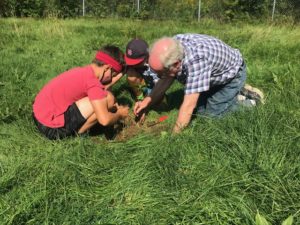
Unlike the midwest however, the natural state of Vermont’s landscape is primarily forested; any grassland natural communities in the state would be limited to wetland and river or lake edges. Therefore in completing work in open spaces, the Burlington Conservation team and partners weigh their options at each site. Would it be best to allow the space to succeed back to forest, to create a managed shrubland community, to create an orchard or food forest, or to create a sunny meadow which mimics the prairie community types of the midwest? When it comes to creating a pollinator garden, Grow Wild uses various plant species present in prairie community types combined with more regionally specific plants to create gorgeous and beneficial habitat for wildlife and people alike.
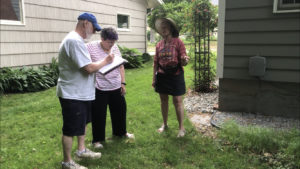
At Edmunds Elementary schooI, I join Grow Wild members Kate Kruesi, a co-facilitator of the initiative and Betsy Hands, who is a parent of an Edmunds student. Out front along main street, Grow Wild helps to maintain two pollinator gardens. As we approach the first garden, Kate spots a native species of sweat bee and explains that parents can take photos on iNaturalist and celebrate what they’ve found with there kids, and you never know if what you might’ve seen is rare! Kate has several decades of gardening experience and is knowledgeable about plants best suited for sites in our city. There are three guiding principles around the design of Grow Wild’s pollinator gardens, and Kate says it best.
The first point is about the pollinators themselves because “our native bees and insects in general have 12 month life cycles but they emerge in different months of the summer.” These insects need to complete their life cycle and raise their young, and therefore point two is that “their larvae need protein and fats to grow, so we need to provide pollen in every month of the year.” Additionally, “In order to have the energy to fly around and to mate, we need to provide nectar sources throughout the season”. Finally, these pollinators “have different tongue lengths, you want to think of [planting] different flower shapes and sizes”. Spending only a morning at the garden, it was astounding to see the diversity of insects visiting the flowers from minute sweat bees to moths and parasitoid wasps. As Kate and Betsy described their dreams for the gardens, I became curious about how they came about.
The Association of Vermont Conservation Commissions provided the funding through the Tiny Grant Program and that was used to supplement the garden material, plants and staffing support from the City of Burlington. Betsy explains how it all started when she enrolled in the Vermont Master Naturalist Program (VMN). “I took Alicia Daniel’s Master Naturalist class for the 2021-2022 season. To complete the program, I chose to organize a project that combines rewilding and working with school kids. I have a third grader at Edmunds, and the location along Main Street is ideal to boost public awareness, and involves kids and teachers. Middle school kids even got involved and made beautiful signs to indicate plants in the garden!”
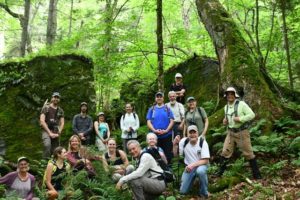
Betsy worked with Kate Kruesi and a team of teachers to develop a proposal. Kate was essential in a schematic plan for the plants. BPRW and the Tiny Grant Program have made this project feasible, but ultimately Betsy hopes to get more families involved. It is through small, tangible projects like this one, inspired by the Grow Wild, that volunteers envision a future of community and neighborhoods with these gardens all over the city.
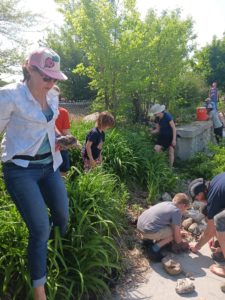
I met with Tori Hellwig, a graduate student at The University of Vermont, at the pollinator gardens at Lakeview Cemetery off of North Ave. Tori initially got involved with Grow Wild in working with Alicia Daniel during her studies. For credit toward her master’s degree, Tori used the LVC garden as an opportunity for intentional design. This space explores how landscape design could be used as a method for research but also as a project for applied habitat enhancement. “It was really inspiring to see this garden covered in pollinators and other insects immediately! It’s exciting, it worked!”
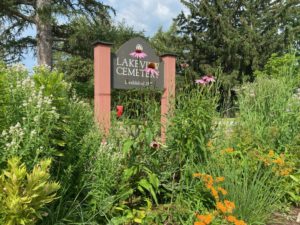
Working alongside Tori was Heidi Western, another member of Grow Wild who began as a VMN student when she took the program for professional development credit while teaching language in high school science classes. Had you been a long-time gardener? “Yes!” Was that a big transition for you to use native plants? “It was easy, it just made sense. One thing I learned about is straight species versus cultivars and clones. Nursery plant tags may say ‘native plant’, but [if they’ve been modified], they aren’t choice morsels for our native pollinators”. Heidi is also involved in writing an annual report for the Xerces Society’s Bee City program in which Burlington is a part of, you can read more here: Burlington Bee City . Grow Wild has collaborated in efforts like The Old North End Ramble, City Nature Spectacular in the spring, and these efforts are prominent in our goal of getting plants out to the community and establishing pollinator resources.
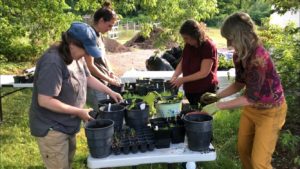
For those unfamiliar with the Vermont Master Naturalist program, I spoke with Alicia Daniel, the founder of the program to talk about how it came about and how it connects with Grow Wild. Alicia says that after teaching for 30 years in the UVM field naturalist program, she became very interested in bringing a slice of that training to the people of Vermont. “I decided to found the VMN program and go into towns and recruit 15 participants [annually]. Participants receive training in the natural history of their town from the geology, to glacial history, winter ecology, settlement history, all the way up to the present day. And through that training, people start to see the natural communities, and understand how their landscape is working”.
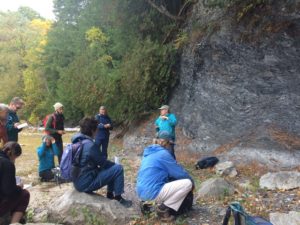
Alicia describes how students visit beautiful natural areas in each of their towns and then students get involved in their local community by working on team volunteer projects to complete the program. Alicia believes that this place-based model allows for a passionate approach to education. Some of these talented, passionate naturalists are also gardeners who want to do the work of creating new habitat for pollinators and other wildlife, and that, says Alicia, is how so many VMN students end up involved in Grow Wild.
Creating new habitat doesn’t end with pollinator gardens. BPRW has been focused on intentional reforestation efforts to create better habitat connectivity and improve ecosystem services. Oakledge and McKenzie parks are great examples of the ongoing work with the community and partner organizations. Though it has been a few years since the start of the project, the old softball fields of Oakledge park have been turned into bird habitat through replanting efforts with Audubon Vermont and numerous volunteers. At McKenzie park, located on an interior bend of the Winooski river, a large planting of trees was completed in the hayfield to reestablish a riparian buffer and offer food, nesting, and many other resources to wildlife.
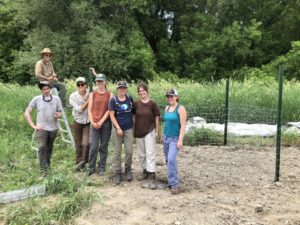
I got the chance to spend a morning with Katarina Keating of BPRW, an integral person behind the ongoing success of many of these efforts. Katarina and I hop into a water truck and visit these sites. She explains how when she first started, much of her work involved watering these young plants, giving them a good chance at survival and taking note of the health of the plants. Katarina mentions another project along Manhattan Drive called the North Bend Orchard.
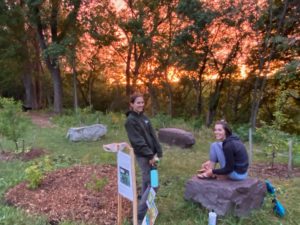
This project was brought to the BPRW conservation team by neighbors who wanted to make use of the green space in their community. The orchard offers a selection of fruiting, nut-bearing, and berry producing trees and shrubs marked with hand painted signs. There are boulders for resting on, to take a moment to pause or connect with friends and a short trail leads through the edge of the trees with a view out over the Intervale.
When asked about the space before the orchard initiative, Katarina describes it as having a variety of invasive plants and a bank strewn with trash and other signs of its state of long-term neglect. “We’re always going to have these invasive plants, we’re always going to need management of these spaces and we’re always going to need people caring for them.” There have been people on this land as long as it’s been unglaciated, and they’ve always been tending to it, modifying it in some way. Hopefully this orchard sparks a bright future for this stretch of land and those living there.
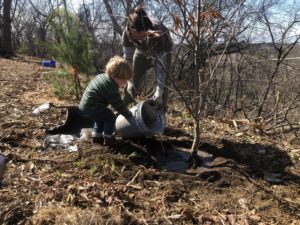
Interested in how invasive plants are intersecting with the conservation work in the city, I met with Steven Blaisdell, owner and Invasive Plant and Restoration Specialist at Balanced Ecological Systems. Steven describes work with invasives as daunting. “You’ve got climate change, habitat destruction, topsoil loss, [forest] fragmentation, and this is just another piece in that puzzle. The big picture is tough but you do what you can.” And he certainly does; I find Steven at Kieslich Park where he is hard at work removing invasives and beginning the replanting effort. Kieslich is part of a mesic sandplain natural community and trees, shrubs and herbaceous plants have been selected to take the place of the plants that get removed. You’ve got to pull and plant, says Steven, and as he works, he throws down a seed mix of herbaceous plants from Prairie Moon, fit for the soil conditions, hydrology, and our location.
When asked about community reaction, Steven says, “gratitude. Usually ‘thank you’, because they’re probably pulling it out of their backyard”. He goes on to mention research being conducted at Cornell that suggests that over larger periods of time, certain invasive plant populations will balance out and the species could naturalize but right now our forests are in trouble and that’s affecting insect, bird and other wildlife populations. As Steven believes, we don’t have 200 years to wait.
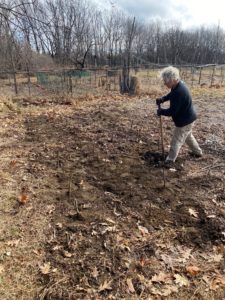
Steven’s work doesn’t end there, when speaking to Nate Millarhouse about a tree and shrub nursery project he’s working on at the Starr Farm community garden. I discovered that early this spring, Steven helped to establish live stake cuttings of dogwood and willow species. The plantings, Nate says, will consist of understory trees and shrubs, woody perennials, and these plants will be used in planting projects at Kieslich park and elsewhere.
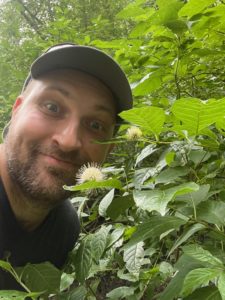
Nate’s interest in plants began with foraging and then he found VMN. “I love to find opportunities to learn and connect with people. The VMN program was one of those places where I got to meet and work with a lot of people and got funneled into a Grow Wild community project”. Nate mentions that he worked with his previous landlord and Grow Wild to transform his front yard into a native plant landscape. The landlord hired a Grow Wild member to design the planting and Nate is very excited about it. There won’t be any need for mowing and as he’s noticed on the local facebook group, neighbors are connecting with neighbors around these Grow Wild resources.
The Starr Farm nursery is just one of many being established around the city. I met with Ben Rodgers, Conservation Field Coordinator at BPRW, and Dr. Laura Hill, a senior lecturer of the UVM Department of Plant Biology at Tommy Thompson Community Gardens. This garden site is the largest and longest-running of the Burlington Area Community Gardens program and a confluence of pollinator gardens, fruit trees, and nursery stock and other perennial plantings.
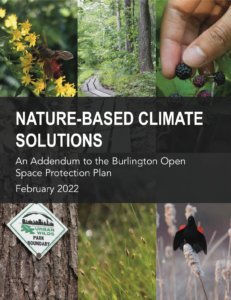
Laura first got involved after reading the Climate Change Addendum to the Burlington Open Space Protection Plan. Laura was looking for ways to incorporate local community partners, climate action, and nature based climate solutions and found support through the UVM Faculty Fellows program which allowed her the opportunity to design a community-engaged internship. Laura got in touch with BPRW and connected with Ben, who served as project sponsor for the class. Ben and Laura designed a six week project that included the management of pollinator gardens at TTCG. This project was able to both meet the needs of the Burlington Conservation Team and the education goals of the students. Ben describes the work as a fruitful collaboration between multiple organizations, and Laura has been doing the research to recommend how best to manage the space. Students involved in the UVM four-week summer internship helped to expand the capacity of the project and help realize the long-term goals. “The students just absolutely loved being out making a change”, says Laura, as she describes how students savor the opportunity to translate the classroom knowledge into action.
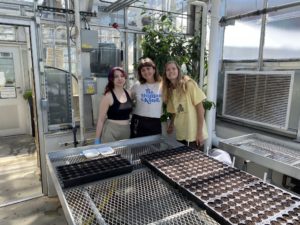
In January of 2021, BPRW applied for and received a grant through the Xerces Society which provided native plants specific to the site, and kickstarted the project. Ben describes how the application involved designing a complete management plan based on the site conditions of Tommy Thompson in order to receive 650 native woody and herbaceous plants to rehabilitate the space.” Ben further describes how both volunteers and other organizations came together to convert this strip, overrun with non-native grasses and other invasive plants, into native plant habitat.
One goal that informed the work of this project was making it a volunteer managed, self-sustaining project. That meant specific native plants to compete with the non-native grasses and mulch to keep the gardens weed-free and flourishing. Eventually, the hope is to source plants, cuttings and seeds from the nursery spaces and get these plants out into the community. Through working with local schools, businesses and organizations, seed processing and collecting days will support a community seed bank that will work as a way for the City of Burlington to help all landowners to have access to these resources.
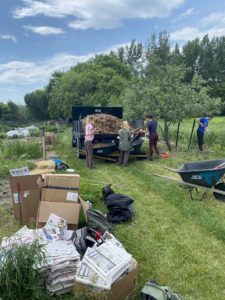
One example of how nature based solutions to climate change are being implemented in the city can be seen at Champlain Elementary School (CES). Students and teachers are working with BPRW to develop a complete nature based curriculum on campus. Projects include a native plant nursery, regenerative plantings, wildlife monitoring, seed collection, and other nature based skills. Every student, PreK-5 has had the chance to plant a tree on campus and engage in the management of the space. Fifth graders spread mulch as a foundation for the nursery, the fourth grade went to Oakledge Park to transplant oak tree seedlings, first, second and third graders helped with seed sowing, and kindergartners learned about, and explored the wildlife corridor.
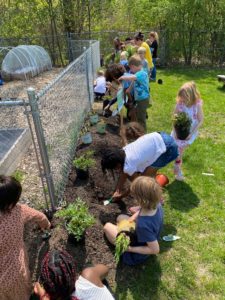
In describing his involvement in the work, Ben acknowledges that other elementary schools and districts have an equal need for the nature-based curriculum. The intention of this program is to develop a system where all schools in the district are getting access to nature based education and for now, it continues to develop. Opportunities to learn hands-on skills in culinary, cultural, and sensory teaching help to develop a sense of place for students. Goals include engaging younger communities in climate action, developing more robust place-based education models, and teaching other fundamental social and emotional learning skills in an outdoor setting.
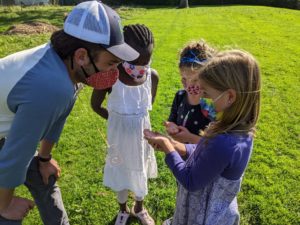
Tori had the chance to partner with CES second grade teachers and students to install a pollinator garden around their native tree nursery. Students shared their knowledge of pollination ecology with Tori, including the need for both pollen and nectar to survive.
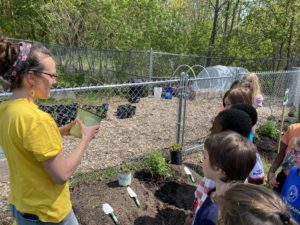
I spoke with Zoe Richards, a parent of three former Champlain Elementary School students, and the Director of Burlington Wildways. “It’s incredible what the kids remember! Insect species, complexity of relationships between native insects and native plants, it really sticks with them”, says Zoe. This connection runs deep and students have been known to eat lunch with their trees. Part of the work involved a project with UVM NR 206 students to create a wildlife corridor connecting Engelsby Brook to a nearby patch of forest.
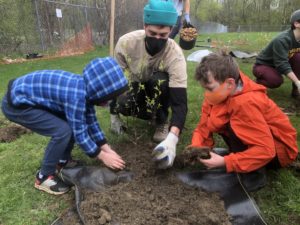
Burlington Wildways is a partnership of the public facing land owners across the city, and Zoe explains how one of the biggest goals of Burlington Wildways is equity and access. “How do we help people feel like they belong in spaces?” One way which Zoe has identified is exposure to the natural world at an early age, and that’s the hope of this programming.

Zoe mentions the Burlington City & Lake Semester which is an award-winning semester program for Burlington High School students. Students engage in various projects around the city and focus on sense of place, community and identity, civic engagement, social justice, and sustainability. As one of the city partners, BPRW engaged with students at Kieslich Park, where students designed and planted a pollinator garden below a mural created by local artist Eliza-Marie Phillip.

Eliza’s mural is really unique project that showcases how place making and art are integral to the relationship building that is a key piece of creating belonging and inviting people into climate adaptation work. Eliza-Marie, who also goes by liza_s_art, chose an intentional and integrated way of installing the mural. From the process of preparing the wall to receive the mural, to the finished project, Eliza layered in connection and relationship. Community members, students, neighbors and visitors to the park participated in the entirety of the mural process. Also, Eliza took time to do more than just integrate community into the actual art. They also focused energy in the relationships and spaces surrounding the mural. This occurred through holding sessions with high school students where they shared about their art and their experience as an artist as well as supporting the planting of the pollinator garden.
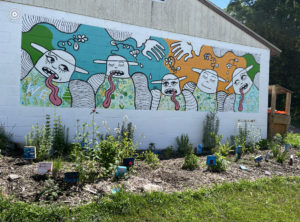
I visited Kieslich park with Katarina Keating of BPRW to stroll along the poetry walk and discuss its history. It’s important to note the deep history of the park space as it was used by indigenous communities as a place for trade, meeting and more for as long as the area has been unglaciated. In more recent times, the land was owned by the neighboring orphanage, then Burlington College, and for a short time the developer of the adjacent site of Cambrian Rise. Today, you can walk the trails, enjoy poetry and art, admire the gardens and enjoy the connection between the Old North End neighborhoods and the bike path.
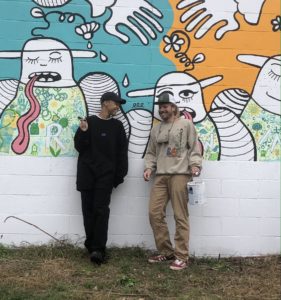
As some folks from Grow Wild have put it, “if you plant it, they will come”. And I believe this applies to wildlife and people alike as our city grows into the future.
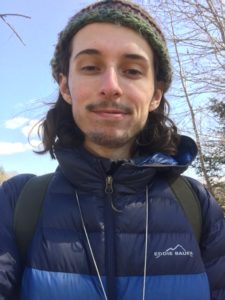 About the Author: Braden DeForge is an artist and botanist and UVM graduate living in Burlington VT. Braden is a volunteer with Native Plant Trust and spent this summer as an intern with Burlington Wildways. Starting this fall, he will serve with VHCB AmeriCorps as the conservation outreach and field specialist for Burlington Wildways and Winooski Valley Park District.
About the Author: Braden DeForge is an artist and botanist and UVM graduate living in Burlington VT. Braden is a volunteer with Native Plant Trust and spent this summer as an intern with Burlington Wildways. Starting this fall, he will serve with VHCB AmeriCorps as the conservation outreach and field specialist for Burlington Wildways and Winooski Valley Park District.
